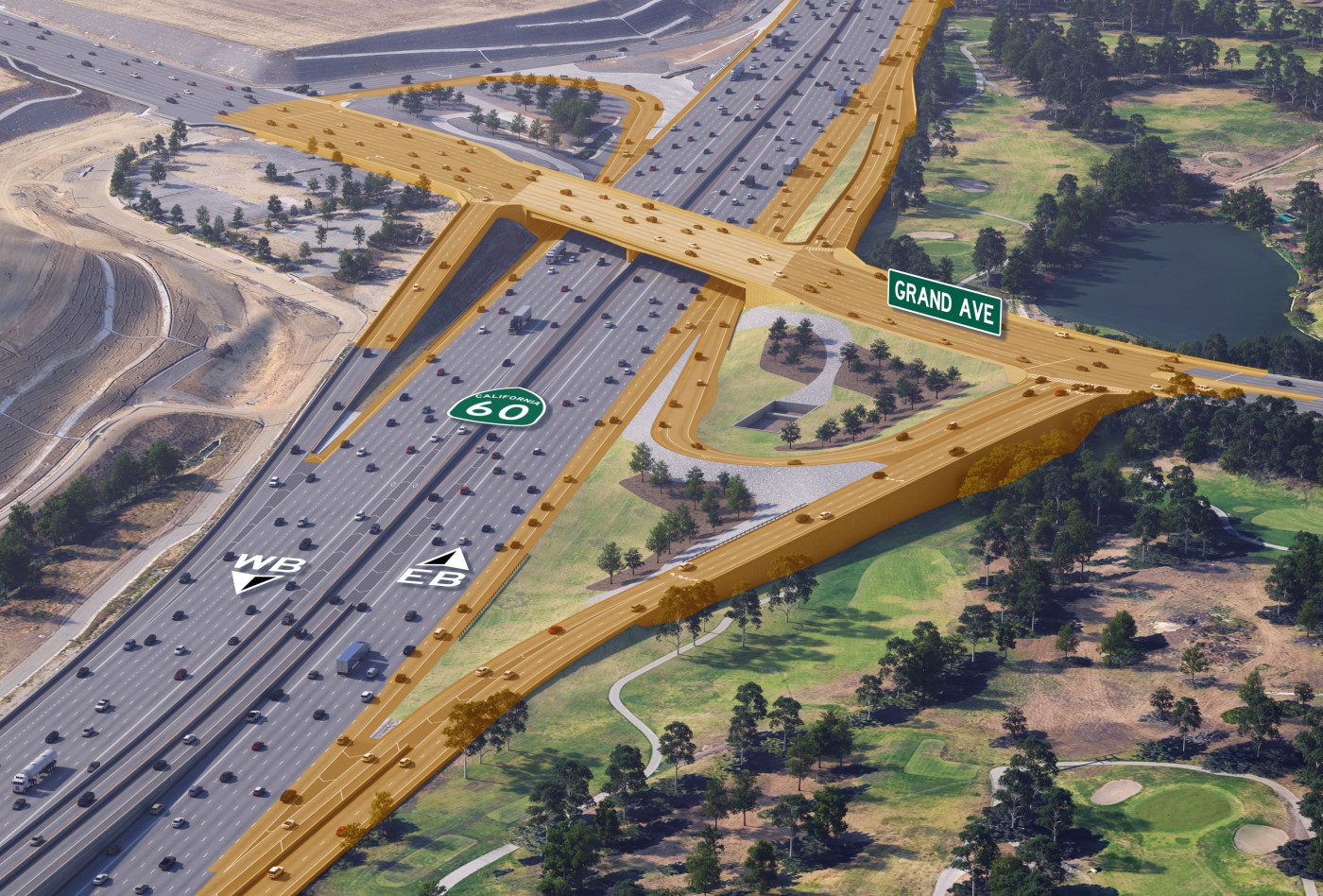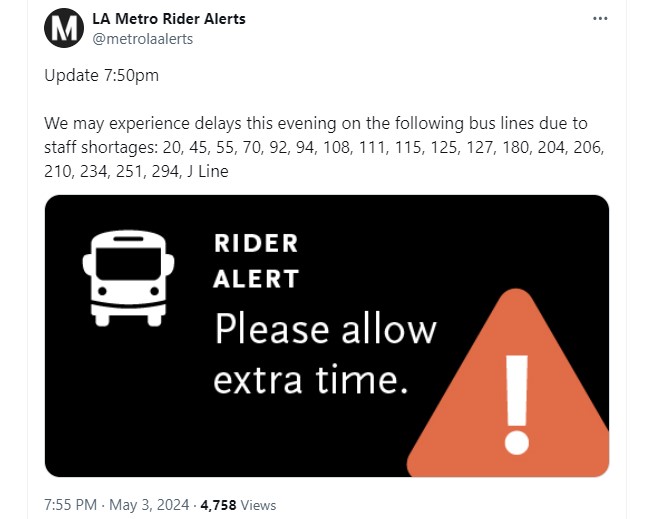Busting Some Metro Highway Program FY22 Budget Myths
1:31 PM PDT on May 25, 2021
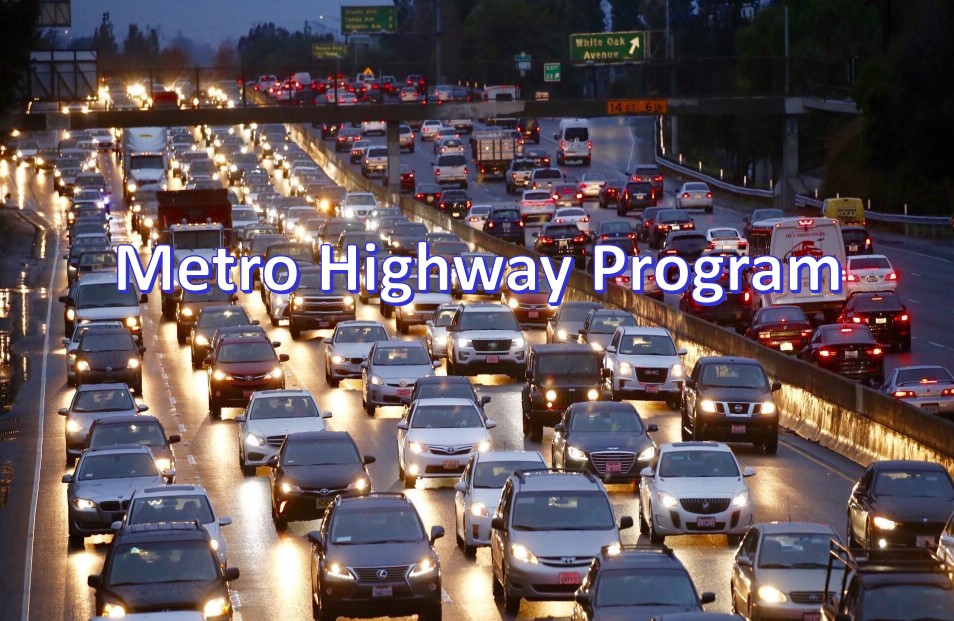
Metro Highway Program image via Metro presentation
This Thursday, the Metro board is expected to approve its annual budget. The proposed Metro FY22 budget weighs in at $8 billion dollars, up eleven percent from $7.2 billion from the FY20 budget - the last one approved before COVID.
There are many factors playing into the increase, including higher construction costs, and (overdue, inadequate) restoration of transit service (see Investing in Place for that story).
One factor that has livability advocates up in arms is a proposed eighty-plus percent increase in Metro Highway Program spending. Last year, Metro approved $264 million for highways; this year the proposed budget ups that to $477 million.
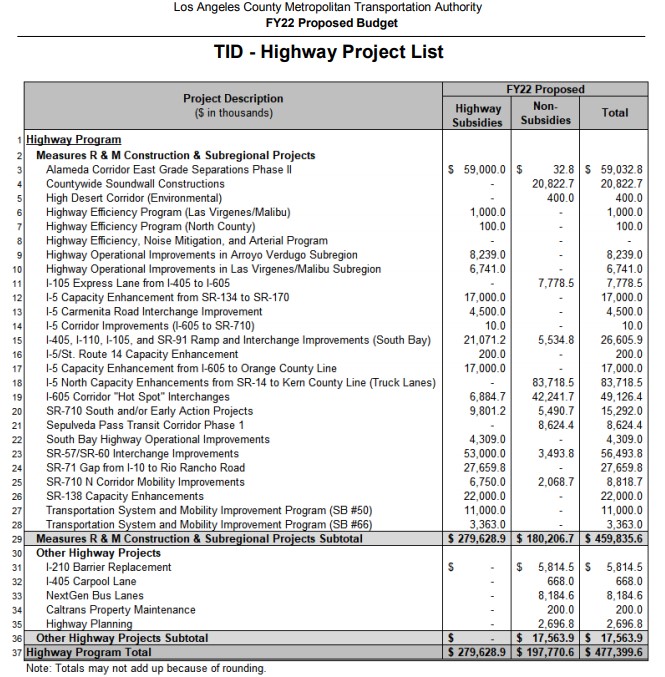
Despite having received "over a hundred public comments asking Metro not to increase funding for highways and highway widening projects," as County Supervisor and Metro Boardmember Holly Mitchell noted during last week's Metro board Finance, Budget and Audit Committee meeting, Metro leadership sought to downplay the concerns of both advocates and boardmembers regarding the proposed spending increase. [See the meeting video.]
When boardmembers asked questions about the large proposed increase for the Metro Highway Program, the responses from Senior Finance Officer Melissa Wang and CEO Phil Washington were inaccurate and misleading.
For overall context, below is an edited transcript of that committee discussion. [beginning at 32:00]. It is followed by a discussion of some of what was said.
Regarding the proposed $477 million Highway Program budget, Metro Boardmember Fernando Dutra noted:
It’s my understanding... that we’re not approving freeway expansions, if you will, and, as I read this, it’s freeway modernization.… We have antiquated interchange designs, you know, that [were] designed back in the '50s and '40s. Now what we’re looking to do is to use some of this money to... look at how we’re going to resolve our corridor projects, and how we’re going to treat our intersections, and how we’re going to treat accessibility and all of those barriers that were caused by antiquated design... All of [which has] led to bottlenecks.
Isn’t the majority of this budget being used for freeway modernization that’s actually going to help with... our corridor issues, our intersections off the freeways, and of course some of our freeway bottleneck areas?
Metro Senior Finance Officer Melissa Wang responded:
You’re absolutely right, Director Dutra. The highway budget for next year does increase a lot. However, let me just articulate a few of the increases we’ve been waiting for years to complete.
The north county portion of the I-5 connecting to Kern County... is a very significant help for our truck goods movement right there. And so there are a few stretches in the north county that...we would like to complete.
The second portion is in the San Gabriel Valley - we’ve been waiting years to finish some of the gap on the 57, on the 71, so those are...not really widening of the freeway. It is actually closing the gap, instead of impacting the local street.
Then...605 the hot spots this year finally [include] Alondra, Artesia and South Street. We’ll finally [be] able to do something to the interchange to make more traffic flow [through] it.
There are 'a little bit' increases actually - as 710 South, for instance, is flat, right? [The] majority of the money goes to local cities for local street improvement, signal synchronization, similar to I-605. What they wanted to do to make sure the traffic can flow easily on and off ramps.
Additional money goes to the soundwall [program] and local subregional [programs] for their own street improvement, so we do recognize it is a significant concern from the public in terms of the highway widening, but the impact in this particular fiscal year of budget is still [in the] very early stage...
Dutra stated that "the days of communities building freeways through communities are gone [but] I certainly think that the days of making an important piece of our transportation infrastructure better, more efficient, are still here." Then he asked:
Correct me if I am wrong, don’t the corridor projects also call for bike lane expansions and things of that nature as well?
Wang responded:
That is correct. Not only [do] we have bike expansion, the ATP - the Active Transportation [Program] - included in that pot of money. In addition...NextGen street improvement is also part of this 280 - this 12 million dollar increase. We [are] changing bus lane[s] - how they actually work together with our local street and the freeway. So it is more than just a freeway expansion.
Metro CEO Phil Washington then added:
The distinction with these highway projects are very, very important. We have been in discussions with Caltrans - some of you may have seen some chatter coming out of that - but to put these highway improvement projects in various buckets, the modifications and the improvements... that distinction is very, very important.
Many of these improvements in this budget impact low-income and communities of color where these improvements will occur. Not widening, but improvements to those interchanges and those things that she just described. What we are trying to do is make sure that we do a good job of explaining those distinctions and making sure that people understand it’s not highway widening, it is hot spot improvements and modifications.
Boardmember Paul Krekorian then stated:
I’m suspect of most highway investment in this day and age - in terms of its return on investment, particularly around capacity expansion...
Where there are investments that will improve public safety on our highways, that certainly makes a great deal of sense. And where there are discrete investments that we can make to reduce congestion, very often those projects may make sense. But capacity expansion is a direction I think that we should consider to be a relic of a prior time and that should just be the philosophy of this agency.
In that regard, Mr. Washington, I want to thank you for your recent comments on the 710 expansion and kind of rethinking some of the issues around stakeholder engagement about widening of the 710. I don’t know where that discussion will end up. I don’t know what the stakeholder engagement will produce, but I do know that this budget still sets aside some money relating to that project. Can you speak to that, and whether - when - it would be appropriate for us to revisit the potential budget issues around that project?
Phil Washington responded:
Well, I think the time is now - to have that discussion, as I said in that statement.
The challenge here is that Measure M has a lot of highway in it. And it is in the ordinance. There has to be a discussion if we are looking - which we should be - to reimagine our approach to highways. Not just here but all over this country.
What I laid out in that statement is bringing stakeholders together to develop a set of principles around that reimagining of highway project improvements - especially the widening piece of that.
The challenge is that we went to the voters. They approved Measure M that has highway projects in it. Of course, now we live in a different world. The challenge this board will have is reconciling that. There is a provision in Measure M that says you must wait ten years before you transfer money. Obviously it’s only been five years or so since 2016. So I think it is a conversation this board has to have. I do think that as we work through this, Caltrans needs to be at the table, obviously, and look at the vision of highways in this state. I think USDOT needs to look at it for the country, as well.
But we do have that measure that says you’ve got not just the improvement projects, but you’ve got some widening in there, too. Not necessarily in this budget for FY22, but you’ve got them in there, and so this board has to make some difficult decisions going forward.
There are quite a few statements there that don't match the actual Highway Program proposals, projects, and plans. Here are ten misleading statements:
1. Dutra: "We’re not approving freeway expansions...it’s freeway modernization"
The Metro FY22 budget proposal includes about $297 million specifically for projects that expand freeways: four projects widening the 5 Freeway, SR57/60 interchange widening, widening the 71, widening SR-138, widening the 710, widening ramps in the South Bay, and more. These are all freeway expansions. Nearly two-thirds of the proposed Highway Program budget is for freeway expansion projects.
Streetsblog's analysis of the proposed FY22 Highway Program budget breaks it down into the follow percentages [see SBLA spreadsheet]:
- Highway expansion/widening: $297 million (62 percent)
- Interchange/ramp/road expansion/widening: $63 million (13 percent)
- Highway soundwalls: $20.8 million (4 percent)
- Miscellaneous highway: $4 million (1 percent)
- Toll lanes: $16.4 million (3.5 percent)
- Grade separations: $59 million (12 percent)
- Highway/road projects supporting transit: $16.6 million (3.5 percent)
(There are a handful of projects that span more than one of these categories and the Metro budget document does not include an exact breakdown, so these amounts and percentages are approximate.)
2. Dutra: "[Is] the majority of this budget being used for freeway modernization to help with our corridor issues, our intersections off the freeways, and freeway bottleneck areas?" Wang: "You're absolutely right..."
The Metro FY22 budget has three allocations for projects that include "intersections off the freeway." These total nowhere near "the majority" of the Highway Program budget. The projects are:
- 605 Freeway Corridor "Hot Spot" Interchanges: $49.1 million - includes 605 Freeway widening
- Lower 710 Freeway and/or Early Action Projects: $15.3 million - includes 710 Freeway widening
- North 710 Freeway Corridor Mobility Improvements: $8.8 million
Two of these three project budgets fund a mix of freeway widening (including on/off-ramps) and nearby off-freeway car capacity expansion. Even if all of these funds were to go to "intersections off the freeway," this only comes to about $73 million - about 15 percent of the overall Highway Program proposal.
Then there are "bottleneck areas." This is not a tightly defined term. For a freeway-builder, a bottleneck could include nearly any stretch of roadway that experiences car congestion. How does one fix a bottleneck area? According to roadway engineers, you widen or expand the highway - see #1 above.
In the past, Metro has asserted that "operational improvements focused at interchanges" don't increase driving. But studies show that this is not the case. Davis researchers note that generally "you’re going to see the highest rates of induced travel and more total induced VMT [vehicle miles traveled] when expanding roadway capacity in congested areas, areas with 'bottlenecks' or unsafe roads, or areas with minimal accessibility."
Much Finance Committee discussion asserted that this or that type of project might not actually be "freeway widening" or "freeway expansion," because it is only widening interchanges, bottlenecks, arterials, ramps, etc. Perhaps the distinction being made is that some of these interchange widening projects do not displace residents - though some do displace. All these widening projects increase driving, and increased driving means more air pollution, more harm to community health, more noise, more global warming.
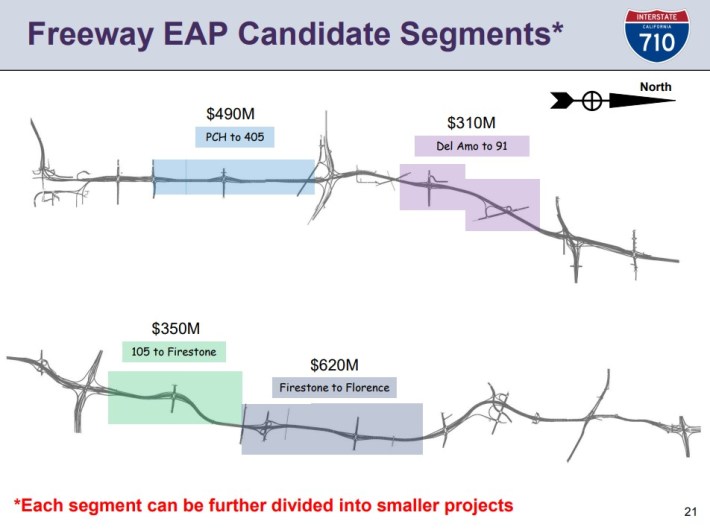
3. Wang: "Finishing the gaps on the 57, on the 71, [is] not really widening of the freeway."
Wang's argument here seems to be that Metro is just making these freeways longer, not wider. This is semantics (or obfuscation), because either way it's freeway expansion.
But is it actually true that Metro is not widening the two freeways that Wang cites? No.

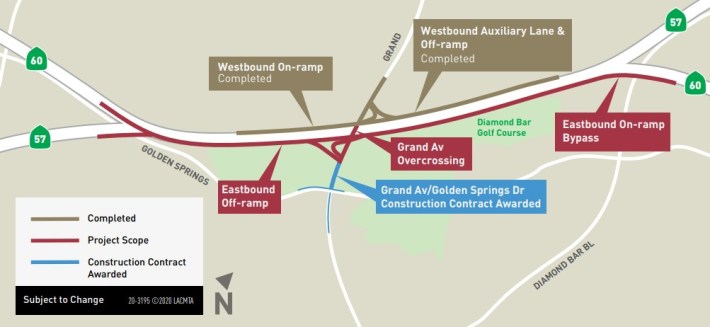
For the 57 Freeway project, Metro is adding just over two miles of a new "bypass lane," effectively widening the freeway.
Metro's 2020 71 Freeway project factsheet states that Metro would be "adding one mixed flow lane and one High Occupancy Vehicle (HOV) lane in each direction on State Route 71 (SR-71) and converting the existing four-lane expressway to an eight-lane freeway." That's really widening.
4. Wang: "We do recognize it is a significant concern from the public in terms of the highway widening, but the impact in this particular fiscal year of budget is still [in the] very early stage"
Wang tries to have it coming and going. Per her earlier testimony, some of Metro's highway projects are ones that "we’ve been waiting for years to complete" and others are in the "very early stage." Wang's statements here represent one more iteration of a characterization that the Metro Highway Program often likes to make: it isn't the right time for the public (or the Metro board) to weigh in because it's too early or too late. These are highways with no off-ramp.
These same whipsaw arguments were used by Metro Highways to attempt to ward off community opposition to 605/5 Freeway widening, which Metro asserted was simultaneously "in the very early stages" and "identified decades ago."
Wang's statement is just not true. There is not a single freeway project in this year's budget that is truly in the "very early stage." The vast majority of the projects were approved, in some form, years ago. Metro has already spent millions of dollars designing and engineering them. A few - most notably the 710 Freeway expansion - have also been opposed for more than a decade.
5. Dutra: "Don’t the corridor projects also call for bike lane expansions and things of that nature as well?" Wang: "That is correct. We have bike expansion, the ATP - the Active Transportation [Program] - included in that pot of money."
There are no bike lane expansions in the Metro Highway Program FY22 budget. There are no ATP projects either. None.
(If one digs deep, one can spot a few very minor components of billion+dollar highway widening that will reconstruct a sidewalk or widen an existing pedestrian overcrossing, but these are horribly pedestrian- and bicyclist-unfriendly facilities. None of these should be considered "expansions" of bike facilities. It's difficult to calculate what amount of the highway budget is allocated to these facilities, but it is well below one percent.)
Many cities - from Long Beach to South Pasadena - have pushed for Highway Program projects on city streets to include complete streets components (e.g. bike lanes). There is a Highway Program flexibility proposal expected to be approved soon. But right now, Measure M and Measure R sales tax Highway Program funding is blocked from being spent on bikeways and other things of that nature.
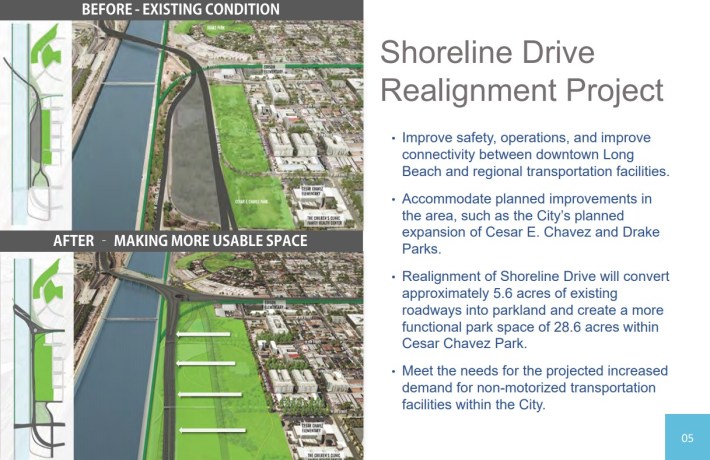
6. Wang: "NextGen street improvement is also part of [the proposed Highway Program budget]."
The FY22 Highway Program budget includes four projects designed to benefit transit riders:
- High Desert Multi-Purpose Corridor - $400,000 for studying high-speed rail where a proposed freeway was canceled
- North 710 Freeway Corridor Mobility Improvements - a small portion of the $8.8 million will go to some L.A. City projects that support transit (this is from canceled 710 Freeway tunnel funding)
- NextGen bus lanes - $8.2 million
- 210 barrier replacement - $5.8 million for a project designed to keep trucks from crashing into the L Line in the Pasadena area
These projects are in the Highway Program budget - and should be the last things that the board would cut from that budget. But (generously assuming that maybe at most a quarter of the North 710 money goes to transit) this ~$16 million worth of transit projects comprise a small portion (~3.5 percent) of the $477 million Highway Program proposal.
7. Wang: "[NextGen bus lane projects include] how [buses] work together with the freeway. "
No FY22 NextGen projects interact with freeways. Wang does mention streets, which is where the NextGen bus lanes will be.
This declaration is similar to another Metro Highway Program myth. The Highway Program sometimes claims that freeway widening projects benefit transit (see their presentation on the proposed 605 Freeway widening) but when questioned, the benefit is revealed to be that Metro could someday choose to run its buses on these widened freeways.
8. Washington: "Many of these improvements in this budget impact low-income and communities of color where these improvements will occur. Not widening, but improvements to those interchanges and those things [apparently NextGen] that [Wang] just described. What we are trying to do is make sure that we do a good job of explaining those distinctions and making sure that people understand it’s not highway widening, it is hot spot improvements and modifications."
It is not entirely clear exactly what Washington was referring to here. From the context, it sounds like Washington is using "impact" to describe "benefit." The $8.2 million for NextGen bus lanes definitely positively impacts - benefits - low-income and communities of color, but NextGen is just 1.7 percent of the Highway Program budget.
In contrast, the "interchange improvements" and "hot spot improvements" that Washington refers to (apparently 605 Hot Spot Interchanges and the Lower 710 Freeway Early Action Projects) both include many road widenings located in low-income areas and communities of color.
Just locating a project in a low-income community does not mean that project advances equity. The question is not just where, but who are these improvements for?
These projects are nearly all widening interchanges, ramps, and arterial roads to make it easier for more people to drive through these areas. Though some lower-income people depend on cars, many lower-income people (including seniors and students) do not have cars. More cars through low-income communities offers some mobility benefits for some residents, but at the cost of worsened air quality.
Washington seems to be brushing off these negative impacts as a public relations issue that Metro needs to explain better.
9. Washington: "Voters approved Measure M highway projects."
Voters certainly approved Measure M, back in 2016. The ordinance's expenditure plan lists highway projects - with a ~50-character description, a schedule, and a dollar amount. But that leaves a lot of wiggle room for Metro board and staff to finalize what ultimately gets built.
The Highway Program regularly insists on a scope very different than what was in place at the time that Measure M was approved.
In 2016, there were more than a dozen alternatives in play for the project described in its entirety as "I-710 South Corridor Project" in Measure M, but the Metro board later went on to select a widening project.
The most egregious example is Metro's proposed home demolitions as part of the 605 Corridor Improvement Project (which includes widening three miles of the 5 Freeway at the 605). At the time that voters approved Measure M, Metro's plans for that portion of the 5 Freeway showed three alternatives: demolishing 15, 25, or 102 residential parcels. In 2020, Metro "drastically" widened its plans, announcing that the project would demolish between 283 and 310 parcels (nearly all homes and apartment buildings) in Downey and Santa Fe Springs. After pushback from the affected communities and the Metro board, Metro Highway Program staff announced that they had pared back demolitions to roughly 185-219 parcels - still 100-700+ percent more than what "voters approved."
10. Washington: "[In Measure M, there are] not just the improvement projects - you’ve got some widening there, too"
Broadly Phil Washington is correct in characterizing Measure M as having a great deal of highway funding, expected to include widening. Highway projects were included deliberately as a political calculus in hopes of getting drivers to support a broadly multi-modal funding measure. Washington is correct to anticipate that Measure M highway funding means that the Metro board "has to make some difficult decisions going forward" including the big sales tax funding shifts can only come every ten years.
But is there definitely "widening" in Measure M?
Not really.
The word "widening" does not appear in the Measure M ordinance. Nor does "highway expansion." These are implied in broad descriptions like "reduce bottlenecks" and "ease traffic congestion." Measure M highway project descriptions were are all cloaked in language like "corridor improvements," "multi-purpose corridor," "interchange improvements," and "highway efficiency program."
To say that Metro is just widening highways because "that's what the voters approved" is to push a highway widening agenda that was not explicitly stated in Measure M.
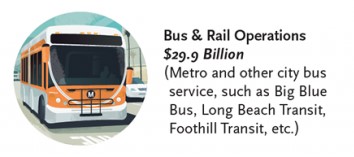
Contrast this with expanded Measure M funding for transit operations. Transit riders are looking forward to the day when someone - anyone - at Metro announces, "We have to expand transit operations because that's what the voters approved."
For highway projects in Measures M and R, it is up to the board to decide the project scope and schedule. A big part of this is approving an appropriate highways budget. If the board wants to prioritize equity, housing, and climate, it can rein in the excesses of the Metro Highway Program, while meeting the literal language in Measures M and R.
Where does Metro go from here?
The budget process is a very difficult place to make changes on the fly. It's typically a high-stakes up/down vote. Always up, though.
Advocates - including Happy City Coalition and Streets for All - are calling for no increase in the highway widening budget. The Metro board can do that this week, in the budget vote. The board can send the budget back to the Highway Program and tell them to bring back a revised version with no increase. This could take the shape of no increase in the locally-funded portion of the Highway Program budget, with exceptions for some components: the four transit projects (High Desert Corridor, NextGen bus lanes, 210 barrier, and transit components of the North 710 Corridor), ExpressLanes projects, and Alameda Corridor grade separations. One way to keep things contained while waiting for a new right-sized Highway Program budget would be to pass a continuing resolution (similar to last year's entire Metro budget under COVID) to keep spending at current FY21 levels until the new version is approved.
If that needed pause on increases is too heavy a lift, then here are a few smaller steps that the board could take this week to rein in highway spending increases:
- $15.2 million for the lower 710 Freeway. As Phil Washington noted "the time is now" to respond to the 710 Freeway widening budget. The community says this project is harmful, the EPA says it's illegal, and Caltrans says it's on hold. If the board can't pull the plug on 710 Freeway funding right now, then when can it? If not now, when?There are two 710 motions coming to the board this week. There are also several worthwhile 710 early action projects on hold pending Highway Program modernization policy approval. How about putting a hold on all new lower 710 Freeway project spending until the Highway Program responds to the board's 710 Freeway motions, and the modernization policy is approved?
- $49.1 million for 605 Freeway Corridor "Hot Spot" Interchanges and $8.8 million for North 710 Freeway Corridor Mobility Improvements. Similar to 710 early action, both of these programs could benefit from including complete streets elements where appropriate, as proposed in the Highway Program modernization. It will be difficult to pause tranches of money for projects already in construction, but how about pausing new construction and new project development spending until the Highway Program modernization is approved?
- $10,000 for the 5 Freeway from the 605 to the 710. This is the most destructive part of the 605 Freeway Corridor Improvement Project, which the October board motion effectively put on hold until Metro Highway Program did outreach, trimmed the project scope, and reported back to the board. How about putting this money on hold until after the Highway Program reports back?
- $56.5 million for the 57/60 interchange. Measure M voters approved this project's groundbreaking scheduled for FY25. Now Metro is seeking federal funding (INFRA grant) to accelerate construction to start in 2022. What about putting a hold on these project acceleration funds until the feds decide whether or not to fund the project? That determination should tell the board whether project acceleration makes sense at this time. Why spend more money now to accelerate this highway widening, when Metro could stick to the schedule that the voters approved?
If, this week, the board chooses to increase highway funding by eighty percent, then it would signal unfettered approval for the sort of harmful highway widening that Boardmember Krekorian termed "a relic of a prior time."
As Supervisor Mitchell noted, this week's budget approval is a key point to prioritize making investments that meet the needs of Metro transit riders. Excessive increases in highway funding would soak up flexible funds that Metro could use for bus and rail operations, bus speed improvements, and other not-yet-funded components of Metro's Better Bus Program. It's not straightforward to shift money from highways to buses, but both compete for a limited quantity of flexible funds.
Tune in to the Metro board meeting at 10 a.m. this Thursday where the board will debate and likely, in some form, approve the FY22 budget. Give the board your input via email or phone, if you feel inclined. Follow the proceedings via SBLA Twitter. Board meeting was rescheduled to 11 a.m.
Stay in touch
Sign up for our free newsletter
More from Streetsblog Los Angeles
This Week In Livable Streets
Bike Month continues, Metro 91 Freeway widening, Destination Crenshaw, Culver City Bus, Santa Monica MANGo, Metro bike lockers, Metro Sepulveda Transit, and more
San Fernando Valley Bus/Bike Updates: G Line, Roscoe Bus Lanes, Laurel Canyon Bike Lanes
Short newly protected bike lane on Laurel Canyon Blvd, extensive NSFV bus improvements under construction this month, and scaled-back G Line plans should get that project under construction this summer
No, L.A. City Does Not Always Add Required ADA Ramps During Resurfacing, But They Should
StreetsLA GM Keith Mozee "Any time we do street resurfacing, it is considered an alteration, which requires ADA ramps to be installed."
